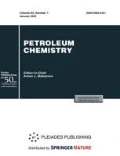Abstract
Optimal formulations of low-viscosity marine fuel (LMF) involving heavy diesel fractions of secondary origin and containing cold flow improvers and antioxidants have been found by mathematical modeling using the pour point, sulfur content, and density as critical parameters. The experimentally obtained characteristics of laboratory LMF samples prepared according to the calculated formulations correlate well with theoretical data and comply with the requirements of regulatory documents. The possibility of involving heavy distillates, produced by Angarsk Petrochemical Company, in LMF is shown. The antioxidant Kerobit TP 26 P is proposed as a stabilizer in the production of LMF composed of a heavier diesel fraction from the atmospheric column of the GK-3 unit and the atmospheric–vacuum distillation residue of the hydrogenated product from units for hydrotreating of heavy middle-distillate fractions of primary and secondary oil refining. The effectiveness of the antioxidant has been evaluated in terms of change in total sediment, which is a measure of oxidative stability, as well as by the existent gum content. The EPR technique has proved the occurrence of radical reactions during storage of heavy diesel fractions of secondary origin and the inhibitory effect of Kerobit-TP 26 P on these processes.




Similar content being viewed by others
Notes
Decision of July 16, 2012 No. 54 “On approval of the Unified Commodity Nomenclature for Foreign Economic Activity of the Eurasian Economic Union and the Unified Customs Tariff of the Eurasian Economic Union”.
PIMS—economic and technological system for oil refining modeling—a tool for constructing oil refining process planning models using linear programming (LP) methods to create optimal plans, including evaluating the alternatives of crude oil, intermediate raw materials, raw materials obtained outside the boundaries of the installation, technologies, and products and markets. Aspen PIMS program (Process Industry Modeling System). Available at: https://www.aspentech.com/en/ resources/brochure/aspen-pims-family (accessed 04 April 2019).
REFERENCES
S. V. Budukva, P. M. Eletskii, O. O. Zaikina, et al., Pet. Chem. 59, 941 (2019).
T. N. Mitusova, M. M. Lobashova, M. A. Ershov, et al., Mir Nefteprod., No. 11, 44 (2018).
T. N. Mitusova, M. M. Lobashova, M. A. Ershov, et al., Neftepererab. Neftekhim., No. 12, 19 (2018).
Zh. N. Artem’eva, I. E. Kuzora, S. G. D’yachkova, and O. V. Starikova, Izv. Vyssh. Uchebn. Zaved., Prikl. Khim. Biotekhnol. 9, 328 (2019).
I. E. Kuzora, D. A. Dubrovskii, V. D. Cherepanov, and S. G. D’yachkova, Mir Nefteprod., No. 3, 51 (2016).
Zh. N. Artem’eva, O. V. Starikova, T. Yu. Posel’skaya, et al., in Proceedings of VII All-Russia Scientific and Practical Conference with International Participation. Prospects for the Development of Technology for Processing Hydrocarbon, Plant, and Mineral Resources (IRNITU, Irkutsk, 2017), p. 129 [in Russian].
Zh. N. Artem’eva, S. G. D’yachkova, I. E. Kuzora, and O. V. Starikova, in Proceedings of XII All-Russia Scientific and Technical Conference “Current Problems of the Development of the Oil and Gas Complex of Russia: Book of Abstracts (Moscow, 2018), p. 199 [in Russian].
Zh. N. Artem’eva, I. E. Kuzora, and S. G. D’yachkova, in Proceedings of Conference on the Demanding Problems of the Petroleum Refining and Petrochemical Complex (Moscow, 2018), p. 57 [in Russian].
A. A. Ganina, I. E. Kuzora, S. G. D’yachkova, et al., Mir Nefteprod., No. 12, 4 (2018).
K. G. Aleksanyan, O. A. Stokolos, E. V. Solodova, et al., Izv. Vyssh. Uchebn. Zaved., Khim. Khim. Tekhnol. 61 (9–10), 120 (2018).
S. V. Kotov, B. Yu. Smirnov, and I. N. Kankaeva, Vestn. Perm. Nats. Issled. Politekh. Univ., Khim. Tekhnol. Biotekhnol., No. 2, 71 (2018).
N. K. Kondrasheva, Chem. Technol. Fuels Oils 2, 13 (2017).
N. K. Kondrasheva, Pet. Chem. 53, 341 (2013).
N. K. Kondrasheva, Neftegaz. Delo, No. 1, 40 (2007).
Zh. N. Artem’eva, S. G. D’yachkova, I. E. Kuzora, and M. A. Lonin, Neftepererab. Neftekhim., No. 9, 35 (2019).
G. Yu. Kolchina, R. F. Tukhvatullin, E. R. Babaev, and E. M. Movsumzade, NefteGazoKhimiya, No. 1, 10 (2017).
V. L. Beloborodov, S. E. Zurabyan, A. P. Luzin, and N. A. Tyukavkina, Organic Chemistry: Book 1, Ed. by N. A. Tyukavkina (Drofa, Moscow, 2003) [in Russian].
L. Lespade and S. Bercion, Free Radical Res. 46, 346 (2012).
Catalysis by Metal Complexes, vol. 21: Activation and Catalytic Reactions of Saturated Hydrocarbons in the Presence of Metal Complexes, Ed. by A. E. Shilov and G. B. Shul’pin, (Springer, New York, 2001).
O. Yu. Poletaeva, Neftepererab. Neftekhim., No. 4, 41 (2014).
A. O. Buza, in World Science: Problems and Innovations: Proceedings of XV International Scientific and Practical Conference, in four parts (Nauka i Prosveshchenie, Pensa, 2017), p. 48 [in Russian].
R. Z. Magaril, Theoretical Foundations of Chemical Processes of Oil Refining (Universitet, Moscow, 2010) [in Russian].
Crude Oil Emulsions: Composition Stability and Characterization, Ed. by M. El-Sayed Abdel-Raouf (InTech, Rijeka, 2012).
T. R. Porter, W. Kaminsky, and J. M. Mayer, J. Org. Chem. 79, 9451 (2014).
Nonhebel, D. and Walton, J., Free-Radical Chemistry: Structure and Mechanism (Cambridge Univ. Press, Cambridge, 1974).
Wertz, I. and Bolton, J., Electron Spin Resonance (McGraw-Hill, New York, 1972).
Author information
Authors and Affiliations
Corresponding authors
Ethics declarations
The authors declare no conflict of interest requiring disclosure in this article.
Additional information
Translated by S. Zatonsky
Rights and permissions
About this article
Cite this article
Artemeva, Z.N., Dyachkova, S.G., Kuzora, I.E. et al. Low-Viscosity Marine Fuel Based on Heavy Diesel Fractions of Secondary Origin: Problems and Solutions. Pet. Chem. 60, 1100–1107 (2020). https://doi.org/10.1134/S0965544120090030
Received:
Revised:
Accepted:
Published:
Issue Date:
DOI: https://doi.org/10.1134/S0965544120090030



